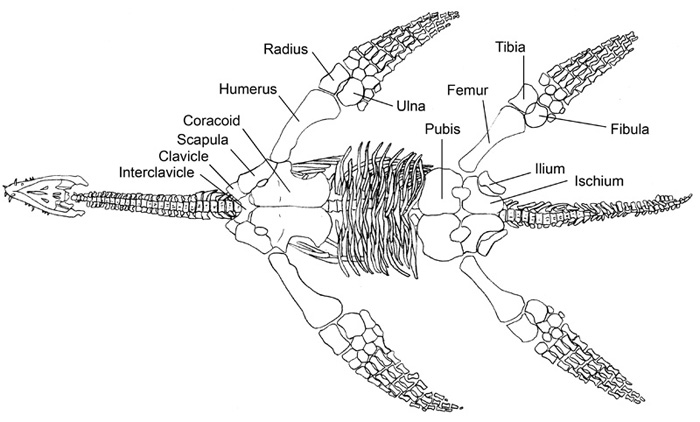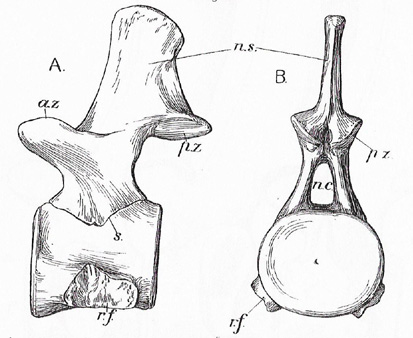Anatomy

All plesiosaurs have four flippers, a short body and a short tail. The skeleton below belongs to Meyerasaurus victor, one of the most complete plesiosaur specimens ever found. It shows the ventral surface (underside) of the animal (redrawn from Fraas 1910).

Cranium and jaws
There is considerable variation in plesiosaur skull anatomy. N.B. This section of the page is currently under construction.
Postcranium
The postcranial skeleton of vertebrate animals is divided into the axial skeleton (the vertebral column and ribs) and the paraxial skeleton (limb girdles and limbs). Unless stated otherwise, the postcranial bones illustrated on this page belong to Muraenosaurus, a cryptoclidid plesiosauroid from the Middle Jurassic (from Andrews 1910).
Vertebrae (general anatomy)
The main cylindrical body of an individual vertebra is called the centrum. A character shared by most plesiosaurs and considered an autapomorphy (diagnostic character) is a pair or more of foramina subcentralia: small openings for blood vessels and/or nerves on the ventral surface of each centrum. On top of the centrum sits a neural arch, which encloses the neural canal, through which the neural spine passed along the spine in life. The neural arch has a pair of processes on the front, the prezygapopyses, with medial (inward) or dorsal (upward) facing facets; and a pair of processes on the rear, the postzygopophyses, with lateral (side) or ventrally (downward) facing facets. The pre- and postzygapophyses of adjacent vertebrae articulate with each other. A tall neural spine projects dorsally from the neural arch.
The axial skeleton can be divided into regions as follows…
Cervical (neck) vertebrae

The proportions of plesiosaur cervical vertebrae vary considerably: long-necked plesiosaurs tend to have relatively elongate cervical vertebrae, while short-necked plesiosaurs have short vertebrae. The articular surfaces of the cervical centra range from amphicoelus (concave) to platycoelus (flat) depending on the species.

The facets for the cervical ribs are situated on the centrum but the rib facets migrate dorsally in successively posterior (back) vertebrae. The rib facets/heads are paired in early plesiosaurs but there is only a single facet in later forms. The cervical ribs are short and hatchet shaped.

Dorsal (back) vertebrae
The cervical series merges into the dorsal series through a transitionary series of pectoral vertebrae. During this transition the rib facets move from the centrum (in the cervicals) to the neural arch, becoming elongate transverse processes in the dorsal vertebrae. These support the long ribs of the rib case. The centra are often distinctly spool shaped.

Caudal (tail) vertebrae
In the caudal series, or tail, the ribs return to the centrum. The caudal vertebrae also bear chevrons on their venral surfaces and the articular faces of the centra are more angular.

Pecotral girlde
The pectoral (shoulder) girdles of plesiosaurs are expanded in thin ventral plates. The main paired element in the pectoral girdle are the scapulae (anterioirly) and coracoids (posteriorly). These form a glenoid cavity to accommodate the forelimb where these meet laterally (on the side). The coracoids always meet along a strong suture on the midline of the animal, and the scapulae may or may not meet depending on the species. A large clavicle-interclavicle complex is present in early plesiosaurs but lost in later forms.

Pelvic girdle
As in the pectoral girdle the pelvic girdle elements form expanded plates. The pubis is situated anteriorly and the ischium posteriorly. The ilium is a small rod-like element which connects the pectoral girdle below to the sacral ribs (which contact the sacrum – part of the vertebral column. The ilium contacts only the ischium (not the pubis) in plesiosaurs.

Gastralia
A basket of tightly packed ‘belly ribs’ or gastralia is situated between the pectoral and pelvic girldles. Each row consists of a boomerang-shaped central element and about three simple gastralia on each side. The posterior row of gastralia contacts (or closely approaches) the anterior margin of the pubis, but there is a substantial gap between the anterior row and the posterior margin of the coracoid.
Limbs
Both the fore and hind limbs are wing-like flippers that closely resemble each other. The propodial (humerus/femur) is relatively long, the epipodials (radius, ulna/ tibia, fibula) are shortened, wider than long in some taxa, and the mesopodials are disc-like. The metapodials (metacarpals/metatarsals) and phalanges (finger bones) are egg-timer shaped. Plesiosaurs have hyperphalangy (increase in the number of finger bones compared to their ancestors). There are several accessory bones in the epi-mesopodial area of many plesisoaur species.

